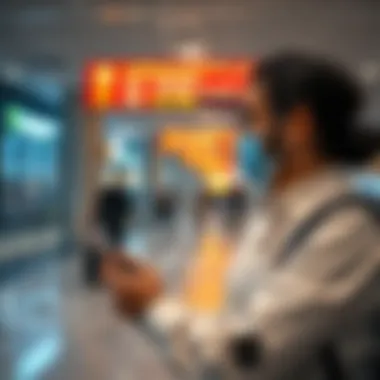Lost and Found Services at Dubai Airport Terminal 1


Intro
Traveling can sometimes turn into a whirlwind of emotions, excitement mixed with a tinge of anxiety, particularly when it comes to managing belongings. When something gets lost, it can feel a bit like losing a piece of your travel experience. At Dubai Airport Terminal 1, one of the busiest gateways in the region, the good news is that there are effective lost and found services designed to help travelers reclaim their misplaced items.
Whether it’s a wallet hastily left behind at a café, a treasured jacket left on an airplane, or a travel document that somehow went astray, knowing how to navigate the lost and found process can be a real game changer. This service plays a pivotal role not only in aiding travelers during their stressful moments but also in maintaining the airport’s operational proficiency. Let’s take a closer look at what’s involved and how you can make the most of these services should you ever find yourself in need.
Understanding Lost and Found Services
Each airport has a system in place for lost and found, and Dubai Airport's approach is no exception. When an item is reported lost or found, it’s logged systematically. The lost and found staff work diligently to reunite items with their owners, ensuring minimal disruption to their travel experience.
In essence, this service embodies the heart of traveler care, acting as a lifeline amidst the hectic bustle of travel. Moreover, it’s worth noting that the diversity of items recovered can range from mundane to quite unique, making for an interesting assortment that reflects the multitude of travelers passing through Terminal 1.
Commonly Lost Items
Many travelers wonder what types of items typically find their way into the lost and found. Here are some examples:
- Electronics: Tablets, smartphones, and chargers often get misplaced.
- Documents: Passports, boarding passes, and travel insurance papers are crucial but sometimes forgotten at security or check-in counters.
- Clothing Items: Jackets and hats are often left behind in lounges or boarding gates.
- Personal Belongings: Wallets and jewelry tend to be more emotionally significant and valuable.
Each item tells a story—whether a cherished memento or essential gear for travel. The operational efficiency of the lost and found service helps to ensure these stories don’t end in anxiety.
Reporting Lost Items
If you happen to misplace something at Dubai Airport Terminal 1, the process to report it is straightforward. Here’s what you need to do:
- Stay Calm: The first step is to maintain your composure; panic won’t help.
- Location Matters: Try to remember where you might have last seen your item. This can direct your next steps.
- Reach Out: Visit the Lost and Found office or contact airport authorities through their official website or customer service hotline.
- Provide Details: Be ready to share specifics—what the item looks like, where you think you lost it, and any identifying features.
This approach not only expedites the recovery process but also aids airport staff in locating your belongings efficiently.
Remember: Describing your item thoroughly increases the chances of its recovery.
Epilogue
While losing an item during your travels can certainly be a hassle, understanding the lost and found framework at Dubai Airport Terminal 1 can mitigate the stress. With dedicated services and a systematic approach to handling lost items, travelers can find solace knowing that help is merely a step away. Navigating through the airport’s processes with this knowledge adds a layer of preparedness to the travel experience, helping to transform panic back into peace of mind.
Intro to Lost and Found at Dubai Airport Terminal
Navigating through the vast corridors of Dubai Airport Terminal 1 can feel like riding a roller coaster in the dark. Amidst the bustling crowds and whirring luggage carts, it’s easy to misplace something valuable. Herein lies the significance of a robust lost and found service. This critical function not only contributes to a fluid travel experience but also provides peace of mind to travelers traversing a busy international hub. With millions of passengers passing through annually, the airport’s lost and found team embarks on an essential mission: reuniting lost items with their rightful owners.
Lost and found services are more than a mundane necessity; they symbolize a traveler-friendly environment that Dubai endeavors to uphold. Understanding the procedures surrounding lost property not only serves practical purposes but also helps to instill confidence. It's about knowing that, should you lose something, there is a systematic approach ready to tackle the issue. Here are some critical aspects to consider:
- Accessibility: The thoroughness of lost and found services can often influence one’s perception of the entire airport experience.
- Security: Every lost item could have sensitive information. Thus, retracing steps is essential not only for recovery but for protecting personal data.
- Operational Efficiency: Efficient handling of lost property contributes to overall airport operations, reducing chaos and enhancing traveler satisfaction.
In a fast-paced environment where stress levels can run high, knowing that there’s a safety net in the form of lost and found services can make all the difference. This article will delve deeper into how Dubai Airport Terminal 1 manages its lost and found, enlightening travelers about the procedures, common items that often go missing, and practical tips for ensuring personal belongings are kept safe. By arming oneself with this knowledge, passengers can traverse the airport with added assurance and clarity, ready to enjoy their journey without the looming anxiety of lost items.
The Importance of Lost and Found Services
Lost and found services hold a vital role in airport operations, serving as a bridge between the often chaotic travel experience and the assurance of recovered belongings. For travelers moving through the labyrinth of Dubai Airport Terminal 1, the presence of such services transcends mere convenience; it embodies the commitment of airport authorities to prioritize passenger satisfaction and traveler safety. Understanding the intricacies of these services can mean the difference between a stressful journey and a seamless experience.
Travelers often carry irreplaceable items, be it a cherished gift from a loved one or important documents needed for a business trip. When these articles go missing, the emotional and practical implications are significant, leading to frustration and anxiety. In a bustling environment like an airport, where the pace is frenetic and distractions abound, the risk of losing items is heightened. Thus, lost and found services are not just about tracking down misplaced goods; they serve as a critical component in catering to the emotional and psychological well-being of travelers.
Ensuring Traveler Satisfaction
The very essence of lost and found services lies in ensuring traveler satisfaction. When a passenger realizes that their item is missing, it can evoke a sense of panic. They may ponder where they last saw it—a tense moment that can stall a journey. Dubai Airport Terminal 1, being one of the busiest airports, acknowledges this worry and strives to address it promptly.
Key elements that contribute to traveler satisfaction include:
- Timely Responses: The quicker an item can be found and returned, the greater the sense of relief for the traveler.
- Comprehensive Reporting System: Having a streamlined process for reporting lost items means that travelers can quickly state what they’ve lost and where it may have been. The less time spent worrying, the better.
- Transparency: Clear communication regarding the process and timelines instills trust. Knowing how long they might have to wait for updates or the status of their lost item can alleviate some stress.
Moreover, airports that prioritize excellent lost and found services can enhance their reputation. Word of mouth spreads quickly. A traveler who feels supported in a moment of despair is more likely to recommend the airport to others.


Security Implications
While traveler satisfaction takes center stage, it is crucial not to overlook the security implications associated with lost and found services. The items that travelers forget, whether benign or sensitive, can pose potential security risks if not handled appropriately. Airports like Dubai Terminal 1 must have rigorous protocols in place for managing these lost items to ensure the safety of all passengers.
Security considerations include:
- Item Authentication: Before reclaiming any found belongings, verification measures must be carried out to confirm the rightful owner. This step is essential to prevent fraudulent claims of lost items.
- Monitoring Suspicious Items: If a bag or object is deemed suspicious, it can cause significant delays and distress. Proper processes need to be in place for handling such situations, which might involve airport security teams.
- Data Protection: Many items may contain sensitive personal information. Airports need to safeguard this information and ensure it doesn’t fall into the wrong hands.
"A proactive approach to lost and found can significantly bolster the overall security framework of the airport, reassuring travelers that their belongings—and by extension, their safety—are taken seriously."
Common Items Found at Airport Terminal
Understanding the types of items that frequently end up in the lost and found department at Dubai Airport Terminal 1 can serve as a compass for travelers navigating their experience at the airport. A common misconception is that only high-value items like electronics or expensive bags are lost. However, many people overlook everyday objects that can also become stranded during a busy travel day.
Knowing what usually gets left behind can provide insights into how to better safeguard one’s belongings during a trip. This awareness can keep you a step ahead, especially if you tend to be a little forgetful while bustling through the airport.
"It's not just about finding items; it's about bringing peace of mind to travelers in their time of stress."
Electronic Devices
When it comes to lost items at the airport, electronic devices such as smartphones, tablets, and laptops often top the list. Travellers in a hurry sometimes forget these essential gadgets in the security trays or at charging stations.
Airport staff frequently encounters an array of brands, from Apple to Samsung, and because these devices often contain personal information, their recovery is a priority. The process for reclaiming lost electronics can be straightforward if you act quickly, involving providing serial numbers and any purchase receipts you might have. Personalization, like unique cases or engravings, can further facilitate quick identification. Keeping receipts and documentation handy can save a lot of trouble down the line.
Luggage and Travel Accessories
Luggage is perhaps the most frequently misplaced item in any travel hub. In the chaos of checking in or during layovers, bags can easily be swapped or left behind. From carry-ons to large check-in luggage, each suitcase tells its own story, and many of them hold more than just clothes. Travel accessories—like neck pillows, large water bottles, and even umbrellas—also often find their way to the lost and found.
Being mindful of how you label your luggage can make a difference. Bright tags or distinctive markers can help in quickly spotting your items amidst a sea of bags. Moreover, ensuring that all your travel accessories are securely packed away or firmly held can reduce the chances of losing them in the first place.
Personal Items
One might underestimate the range of personal items that can be lost in an airport. From wallets and watches to makeup bags and children's toys—these items carry sentimental value, not to mention their potential monetary worth. These personal belongings often get misplaced when individuals rush to their gates or in the security lines.
Many travelers find themselves searching for a beloved item, often recalling where they last had it, only to realize it might never have made it through the terminal. Reporting these losses promptly increases chances of recovery. Keeping a mental checklist of vital personal items while en route can help ensure that nothing important is left unattended.
In summary, the types of items found at Dubai Airport Terminal 1 are varied and often surprising. By staying vigilant and utilizing effective labeling strategies, you can significantly reduce the risk of losing your items and enjoy a smoother travel experience.
Process of Reporting Lost Items
Reporting lost items at Dubai Airport Terminal 1 is a crucial step in the recovery process. Anyone who's ever lost a valuable piece of luggage or a cherished personal item knows how stressful it can be. The Process of Reporting Lost Items is designed to streamline the experience for travelers, ensuring that they can quickly notify the relevant authorities and increase their chances of getting their belongings back.
Immediate Actions to Take
Time is of the essence when you realize something is missing. If you find yourself in this situation, there are a few immediate actions you should take:
- Retrace Your Steps: When you notice something is missing, don’t just stand there. Go back through the places you visited. Check coffee shops, lounges, or restrooms where you may have put down your things.
- Look for Signs: Many times, airports will have signs directing travelers on what to do when items are lost. These could be boards indicating lost and found offices.
Acting swiftly not only aids in potentially locating your item but also sets the tone for an effective report.
Filing a Report
Once you’ve calmed down and retraced your steps, the next step is contacting the lost and found office at Dubai Airport. Here’s how to file a report:
- Go to the Lost and Found Office: If you’re at Terminal 1, find the designated lost and found area. This office is typically well-marked, making it easier for travelers to locate.
- Bring Necessary Information: Have your travel details ready, including your flight number and boarding passes. This information can prove invaluable in locating your lost items.
- Fill Out a Report Form: Once at the office, you need to fill out a form with all pertinent details about your lost item. Accuracy matters; ensure you provide as much information as possible.
Filing a report promptly improves your odds of receiving your lost belongings back, especially if they are turned in shortly after you’ve misplaced them.
Providing Detailed Descriptions
A key component of the reporting process is offering a detailed description of your item. The more precise you are, the easier it will be for staff to locate it. Consider these points:


- Type of Item: Clearly indicate what you’ve lost. Is it a bag, an electronic device, or perhaps a jacket? Each category has different identification markers.
- Brand and Model: Provide the brand, model, and any unique identifiers like serial numbers for electronics. This helps differentiate your item from others.
- Distinctive Features: Mention any noticeable features. For example, if your bag has a unique pattern or a distinct color, make sure to specify that as well.
Important: The more detailed your description, the more likely it is that airport staff can help you recover your valuables.
In summary, knowing how to effectively report lost items at Dubai Airport Terminal 1 not only alleviates stress but also enhances your travel experience. Taking immediate actions, filing a thorough report, and providing a detailed description are essential steps that heighten the chances of recovering lost possessions.
Contacting the Lost and Found Office
To retrieve lost belongings at Dubai Airport Terminal 1, contacting the Lost and Found office is a critical step. Understanding how to navigate this service ensures that you don’t feel like you're looking for a needle in a haystack. Given the sheer volume of passengers that pass through the terminal daily, your chances of recovering lost items rely heavily on knowing the office’s location, accessibility, and operating hours. This makes your lost item retrieval experience more straightforward and less of a hassle.
Location and Accessibility
When you find yourself looking to retrieve a lost item, knowing where to go is half the battle. The Lost and Found office at Dubai Airport Terminal 1 is strategically located, making it a convenient stop for any traveler. Situated just past the customs and baggage claim area, the office is easy to spot with its clearly marked signage.
Getting there requires minimal effort. For those who may have mobility challenges, the airport offers various accessibility options. Escalators, elevators, and other mobility aids are available to ensure all passengers can reach the office without undue stress. In addition, it’s worth noting that the office is near several key amenities, thus allowing for a seamless flow in your overall experience at the airport.
Walking through the terminal can feel overwhelming, especially if you’re in a rush. Therefore, familiarity with the layout ahead of time can aid in swiftly reaching the Lost and Found office.
Operating Hours
Understanding the hours of operation for the Lost and Found office can save you from unnecessary delays or confusion. The office operates from 7 AM to 11 PM daily. This schedule offers ample opportunity for travelers to report lost items or inquire about belongings that were misplaced. However, it's crucial to remember that the airport itself operates around the clock, but the Lost and Found's limited hours mean you must be strategic about when you stop by.
If you find yourself needing assistance outside of these hours, it is recommended to gather as much information about the item and your flight details. Doing so can expedite the process during operating hours. Having your boarding pass, for instance, allows the staff to pull up your travel history quickly, ensuring a more efficient handling of your case.
In summary, knowing the location, accessibility, and operating times of the Lost and Found office at Dubai Airport Terminal 1 can significantly enhance your chances of retrieving lost items. Planning ahead can save you time and reduce stress, allowing you to focus on the essential aspects of your travel experience.
To ensure smooth communication, consider writing down any specific details about your lost items before heading to the office. The more details you provide, the easier it is for the staff to assist you.
Role of Dubai Airport Authorities
The role of Dubai Airport Authorities in the management of lost and found items at Terminal 1 is paramount. They not only ensure that travelers have a seamless journey through the airport but also oversee an organized process to recover lost belongings. A robust framework is set up by these authorities to handle the intricacies involved in lost item retrieval.
Maintaining Order and Safety
With the hustle and bustle of travelers passing through Terminal 1, maintaining order and safety is not just a priority; it’s a necessity. The airport authority puts significant emphasis on safeguarding the property of every individual who steps into its realm. Their presence is felt throughout the terminal; uniformed personnel are stationed at various points to assist travelers.
To achieve this, they've implemented various measures:
- Surveillance Systems: Constant monitoring through CCTV helps in tracking the flow of passengers and any unusual activity, ensuring that lost items can be securely logged.
- Staff Training: Airport personnel are trained not only to assist in finding lost items but also to be vigilant about safety protocols. When someone reports a missing item, the staff responds promptly, understanding the urgency behind such reports.
- Regular Audits: Routine checks and assessments are conducted to ensure that all lost and found items are handled according to strict protocols. This practices fosters a sense of trust among the traveling public.
"Safety and satisfaction often walk hand in hand, especially in high-traffic areas like Dubai Airport."
Coordination with Airlines
Another critical aspect of the Dubai Airport Authorities' role is their coordination with airlines to streamline the recovery of lost items. Each airline has its own policies for dealing with belongings that have been left behind by passengers. The airport authorities act as a liaison between the airlines and the travelers, facilitating efficient communication.
Key components of this coordination include:
- Information Sharing: Authorities gather information about lost items reported by airlines and cross-reference it with items found on the premises.
- Lost Item Protocols: Each airline has specific procedures for handling lost luggage, and the airport authorities ensure that these procedures are followed, thus minimizing the disruption to travelers' experiences.
- Unique Identification: When an item is found, the airport authorities keep meticulous records that include unique identifiers and descriptions provided during the airline’s reporting process. This makes tracking lost items a straightforward affair, enabling a smoother restitution process for passengers.
Timeframe for Item Retrieval
Retrieving lost items can often feel like trying to catch smoke with your bare hands. The timeframe in which you can expect to recover belongings at Dubai Airport Terminal 1 is not just a matter of convenience; it plays a vital role in the overall efficiency of lost and found services. Understanding how the airport categorizes items based on storage duration helps set realistic expectations for travelers and fosters a more organized recovery process.
Short-Term vs Long-Term Storage
At Dubai Airport, items that are found are sorted into categories based on how long they have been in the custody of the lost and found office. Short-term storage typically covers items that have been lost recently—usually within a timeframe of a few days to a week. This is important because such items are often still in demand for their owners, who are usually still in or near the airport. The advantage here is that during this period, travelers can easily contact the lost and found office to inquire about their belongings. Remember, the quicker you act, the higher your chances of a successful recovery.
In contrast, long-term storage is reserved for items that have lingered around longer, often beyond a month. After this period, the airport authorities may begin assessing the potential for disposal or repurposing. The process, though regulated, can differ depending on the type of item. Largely, portable electronics and luggage might get a second glance from airport staff, while other items may head towards disposal sooner. Often, at this stage, there's less hope of reclaiming what was once yours, making it crucial to act fast when you realize something is missing.


Disposal Policies
The policies surrounding disposal of unclaimed items are taken very seriously at Dubai Airport. Generally, items that have not been claimed after a designated period, often 90 days, could be donated or sold. This practice not only minimizes clutter but also aligns with environmental sustainability efforts. It’s for good reason that lost and found offices at airports stress the significance of reaching out in a timely manner.
"The earlier you make your claim, the more likely it is that your treasured item will find its way back home."
Among the items frequently documented for disposal are articles of clothing, toiletries, and those gadgets that never quite made it back to their rightful chargers. It's vital for travelers to be aware of these timelines, as they often carry sentimental value beyond their market price. When in doubt, always ask; just because an item is at the lost and found doesn't mean it will be there for long. Regular check-ups can be beneficial, as what might seem like an unimportant trinket could hold a wealth of memories.
Tips for Preventing Loss of Items
When it comes to traveling, particularly within busy hubs like Dubai Airport Terminal 1, the loss of personal items can be a nightmare. These incidents can lead to frustration, wasted time, and even financial loss. Therefore, knowing how to prevent these misplacements is invaluable for every traveler. By adopting effective preventive measures, travelers can enjoy a smoother experience throughout their journey.
Proper Labeling Techniques
Labeling your belongings might sound trivial, but it can make a world of difference. Picture this: you’ve just landed, eager to pick up your bag, only to discover that it looks strikingly similar to five others nearby. Without an identifiable mark, your chance of retrieving it diminishes. To avoid such scenarios, consider these practices:
- Use Unique Tags: Invest in distinct luggage tags that stand out. Bright colors or quirky designs can easily help you spot your bag among a sea of mundane luggage.
- Include Contact Information: Make sure your label includes your name, phone number, and email address. This way, if someone finds your item, they have a way to contact you directly.
- Securely Attach: Ensure your labels are firmly attached. A flimsy tag can easily fall off during transit.
Integrating these labeling techniques not only safeguards your items but can be the deciding factor in whether your belongings find their way back to you.
Awareness While Traveling
Being present in the moment is an underappreciated skill while traveling. With the hustle and bustle of the airport, it's easy to get distracted. However, practicing mindfulness can significantly decrease the chances of losing your belongings. Here are some tips:
- Create a Routine: Develop a systematic approach when checking your items. For instance, before leaving any area, ask yourself, "Do I have my boarding pass, wallet, phone, and bag?" This mental checklist can save headaches down the road.
- Limit Your Carry-ons: The more items you carry, the more you have to keep track of. Try to limit yourself to one or two bags that you can manage without feeling overwhelmed.
- Stay Alert in Crowded Spaces: Busy airports are ripe with distractions. Try to stay aware of your surroundings, particularly when walking through security or boarding. People tend to be more preoccupied at these stages, which increases the likelihood of leaving items behind.
By enhancing your awareness during these critical travel moments, you lay the groundwork for a worry-free trip.
"It’s not just the journey that matters; what you carry with you along the way is just as important."
In summary, by employing proper labeling techniques and maintaining awareness while traversing the airport environment, you can significantly reduce the chances of losing your belongings. Not only does this approach help in safeguarding your possessions, but it also contributes to a more enjoyable and less stressful travel experience.
Case Studies of Successful Recoveries
When talking about lost and found services, it’s not just numbers and procedures. It's all about the stories that underscore the human element of these systems. Case studies of successful recoveries shed light on how effectively these services function and highlight the significance of their operations within the bustling confines of Dubai Airport Terminal 1.
Why Case Studies Matter
Exploring specific instances of lost items and their recovery offers a unique perspective on the efficiency of the lost and found framework. These accounts serve a number of purposes:
- They provide tangible proof that the system works, boosting traveler confidence.
- They offer insights into common pitfalls and challenges that travelers face.
- They highlight the importance of prompt reporting, adequate descriptions, and patience during recovery processes.
Personal Accounts
Take, for example, a traveler named Anjali, who misplaced a prized vintage camera just before boarding her flight to Paris. The panicked look on her face was unmistakable as she rushed to the Lost and Found counter. Fortunately, airport staff were quick on their feet. With a clear description of the camera's unique strap and specific model, they began a targeted search. Anjali's story ended happily when her camera was recovered within hours, demonstrating the dedication of the Lost and Found team.
Similarly, Rahul, on a business trip, lost his laptop bag containing sensitive documents. After reporting it promptly, he was advised not to panic. The detailed steps he took in assisting the staff—with photographs, timestamps, and locations—proved vital. Within a day, his bag was returned, reinforcing the notion that cooperation between travelers and airport staff can yield success in the recovery process.
Statistics on Recovery Rates
While personal stories bring the narrative to life, they are often underpinned by data. Statistics regarding recovery rates are quite illuminating. Reports suggest that the likelihood of recovering lost items at Dubai Airport Terminal 1 hovers around 80%. This percentage not only highlights the effectiveness of the Lost and Found services but also signifies the commitment of airport authorities and staff to mitigate the stress associated with lost belongings.
Insights from Statistics:
- High Recovery Rates: The substantial rate indicates robust procedures and trained personnel.
- Trending Items: Data show that electronic devices, luggage, and personal items dominate the recovered lists, supporting the need for awareness in protecting these valuables.
- Growing Trends: An upward trend in recovery rates has been reported, reflecting ongoing improvements in training, technology adoption, and public awareness campaigns.
"Every lost item has a story. The more we listen, the better we serve."
In the grand scheme, these case studies and statistics not only provide valuable insights into the operational aspects of lost and found services but also reinforce the need for diligence on the part of travelers. Through stories like Anjali's and Rahul's, the human side of logistics becomes apparent. Awareness, communication, and precise action are crucial components in the journey from loss to recovery, making the airport's lost and found services a vital aspect of the travel experience at Dubai Airport Terminal 1.
Ending
One of the key elements discussed in this article is the efficient reporting system in place. The sooner travelers can report a lost item, the greater the likelihood of recovery. Being equipped with knowledge about how to articulate a detailed description of lost belongings can distinctly improve outcomes.
Moreover, the dedication of Dubai Airport authorities to maintain order while coordinating with airlines reflects a commitment to passenger welfare that enhances the airport's reputation. Understanding these operations can greatly benefit both frequent flyers and first-time visitors who want to avoid becoming part of the lost-and-found statistic.
Travelers should also be aware of the timeframe associated with retrieving lost items. Knowing whether an item will be stored short-term or long-term can influence how quickly you might want to cancel credit cards or replace identification documents. Recognizing these nuances allows individuals to navigate their travels with confidence.
Ultimately, as highlighted throughout the article, the importance of lost and found services cannot be overstated. Each step—from reporting the loss to the retrieval process—forms a support net for travelers, ensuring that their journeys remain as seamless as possible. By taking the time to understand these services, travelers not only maximize their chances of recovering lost belongings but also contribute to a more organized, secure, and enjoyable airport experience.
"Knowing what to do when things go awry is half the battle; the other half is staying informed and prepared."
For more details, you can refer to resources such as Dubai Airport Official Website or the General Civil Aviation Authority for comprehensive information related to airport services.



